





 |
 |
 |
 |
 |
 |
|---|---|---|---|---|---|
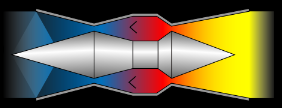 |
 |
 |
 |
|
|---|---|---|---|---|
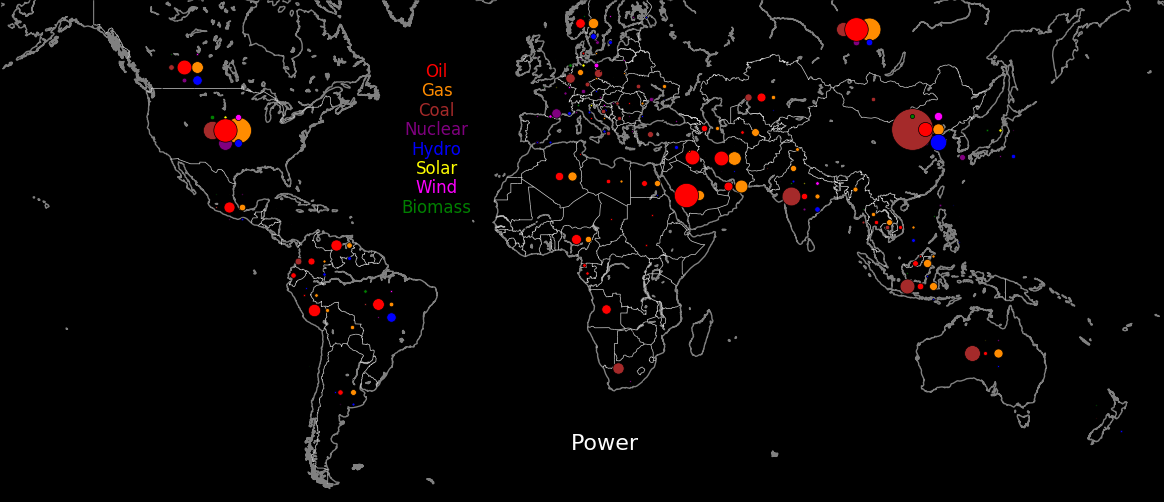 |
|---|
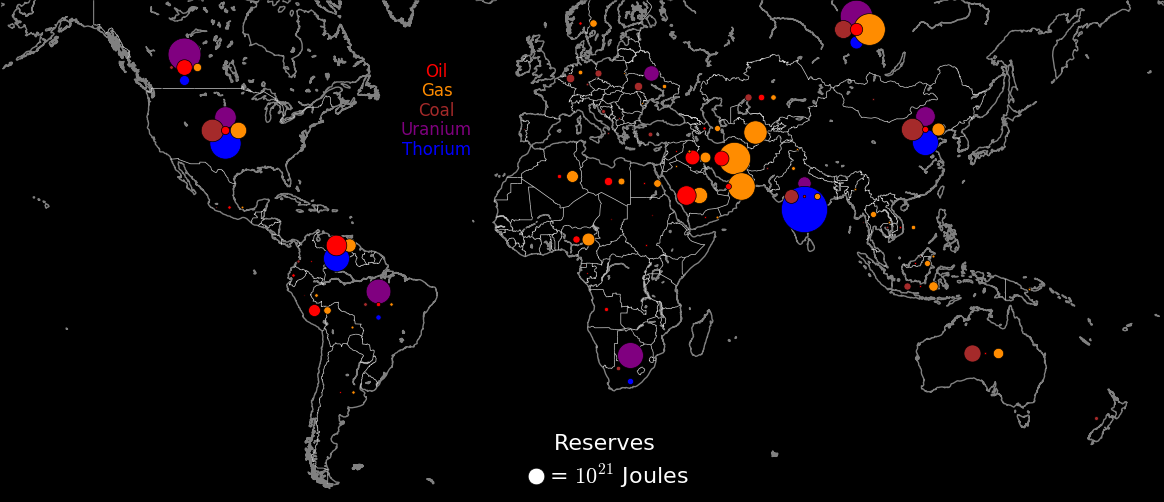 |
|---|
0 Launch into orbit: people, HOX rockets, ice, HOX tanks, habitats, isotope thermal rocket Build a subsoonic air launch platform Build a supersonic air launch platform Build a hypersonic launch track Moon orbit station Moon station Lagrange station Survey the moon Survey the asteroid belt 1 Stockpile space ice Mine the moon Mine asteroids 10 meter telescope at Lagrange station
China dominates the production of most elements, with South Africa in second place. America dominates for only beryllium, rhenium, and thorium. The plot shows the fraction of world production for each element.
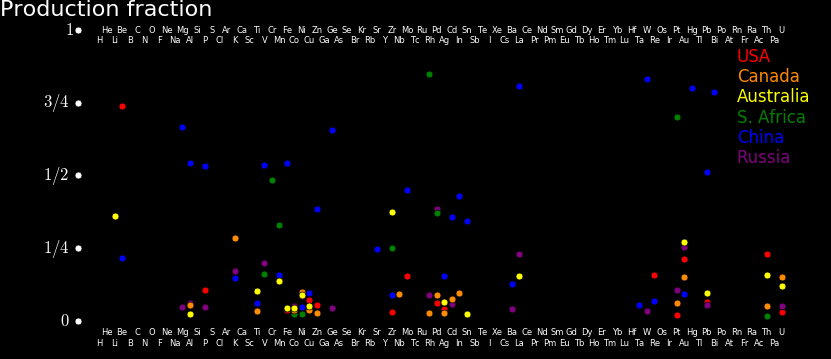 |
|---|
Macrometals are the metals mined by greatest mass. The macrometal superpowers are China, South Africa, Australia, Russia, India, and Canada. America has feeble production. The following plot shows each nation's fraction of world production for each metal. Data is from USGS 2018.
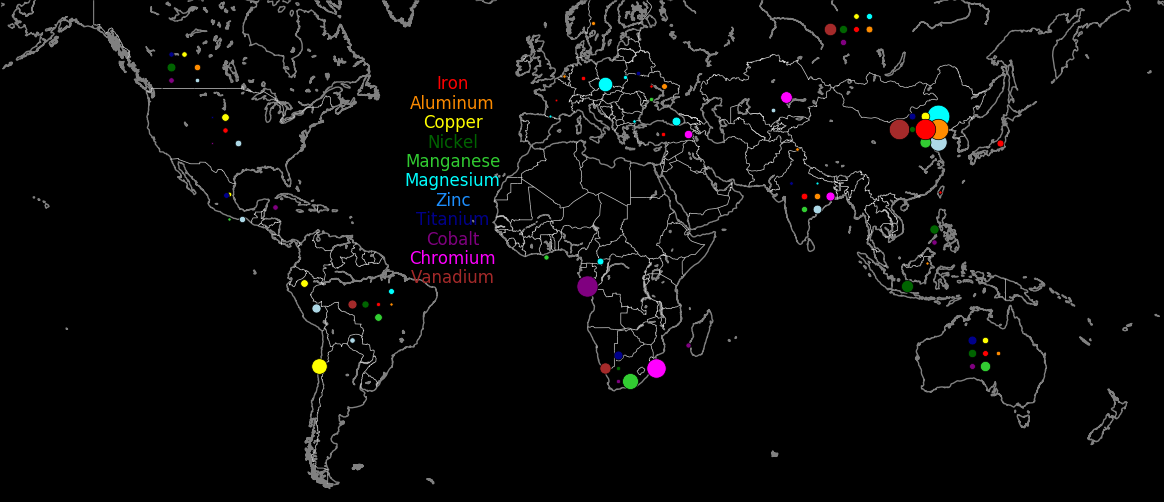 |
|---|
The plot shows the most endangered elements and where they are produced. Many come from conflict zones or from hostile nations. Most come from China.
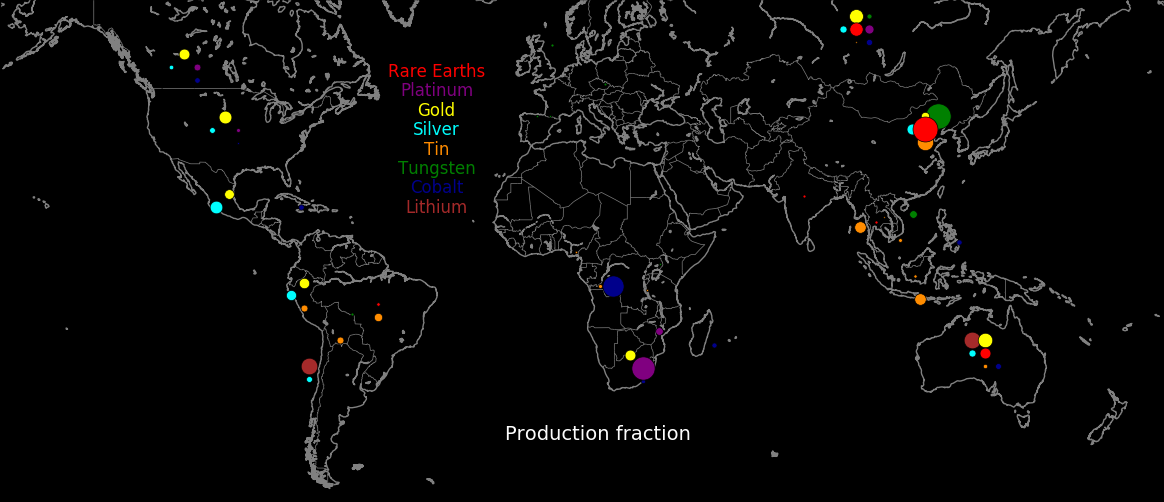 |
|---|
The endangered elements are:
Element Source Use Cobalt DR Congo Lithium-ion batteries, steel alloy Lithium Australia, Chile Lithium-ion batteries Rare-earths China All of the electronics industry, especially solar cells and magnets Germanium China Fiber optics Tin China Solder and bronze Tungsten China Superhard materials in the form of tungsten carbide Scandium China, Ukraine, Russia Aluminum alloy Phosphorus China, Israel, Canada Fertilizer Potassium China, Israel, Canada Fertilizer
There isn't enough lithium and cobalt to build an electric car for everyone in the world.
The ultimite limit to how much food we can grow is from fertilizer, and this hinges on phosphorus and potassium. Biomass power is vast, hence phosphorus and potassium are critically important.
Most endangered elements are endangered because they're produced primarily in China.
Elements that are important but not endangered include:
Platinum Canada South Africa Catalyst Palladium Canada South Africa Catalyst Rhodium Canada South Africa Catalyst Rhenium Chile USA Peru Poland Aircraft turbines Osmium Superhard metal Iridium Superhard metal Molybdenum Strong metal Beryllium USA Strong lightweight metal Tantalum Australia Brazil Canada Capacitors and is produced in Australia, Brazil, and Canada. Nickel Worldwide Steel alloy. Turbines Caesium Canada Drilling lubricant in the form of caesium formate Gold USA Canada Australia Currency Silver Mexico Peru Solar cells Copper Chile Peru USA Aus Chi Power wires Gallium Worldwide Extracted from aluminum ore Uranium Worldwide Nuclear energy Thorium Worldwide Nuclear energy
The following plot shows world production for each element. Endangered elements tend to be near the bottom.
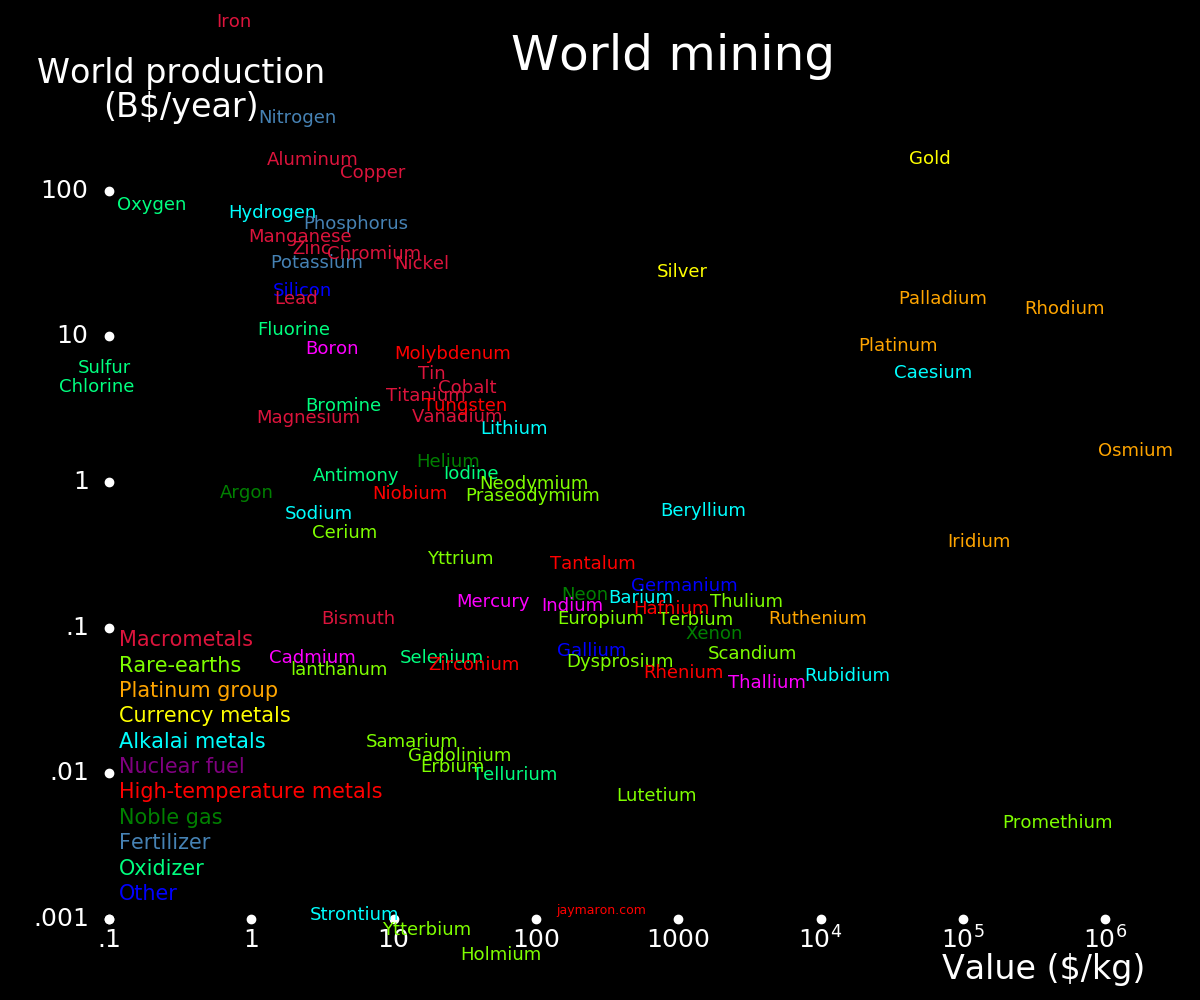 |
|---|
The embodied energy of an element is the energy required to extract the element from ore, in Joules/kg. Most of the price of elements is from energy. For steel, the energy comes from coal smelting and for most of the other elements the energy comes from electricity.
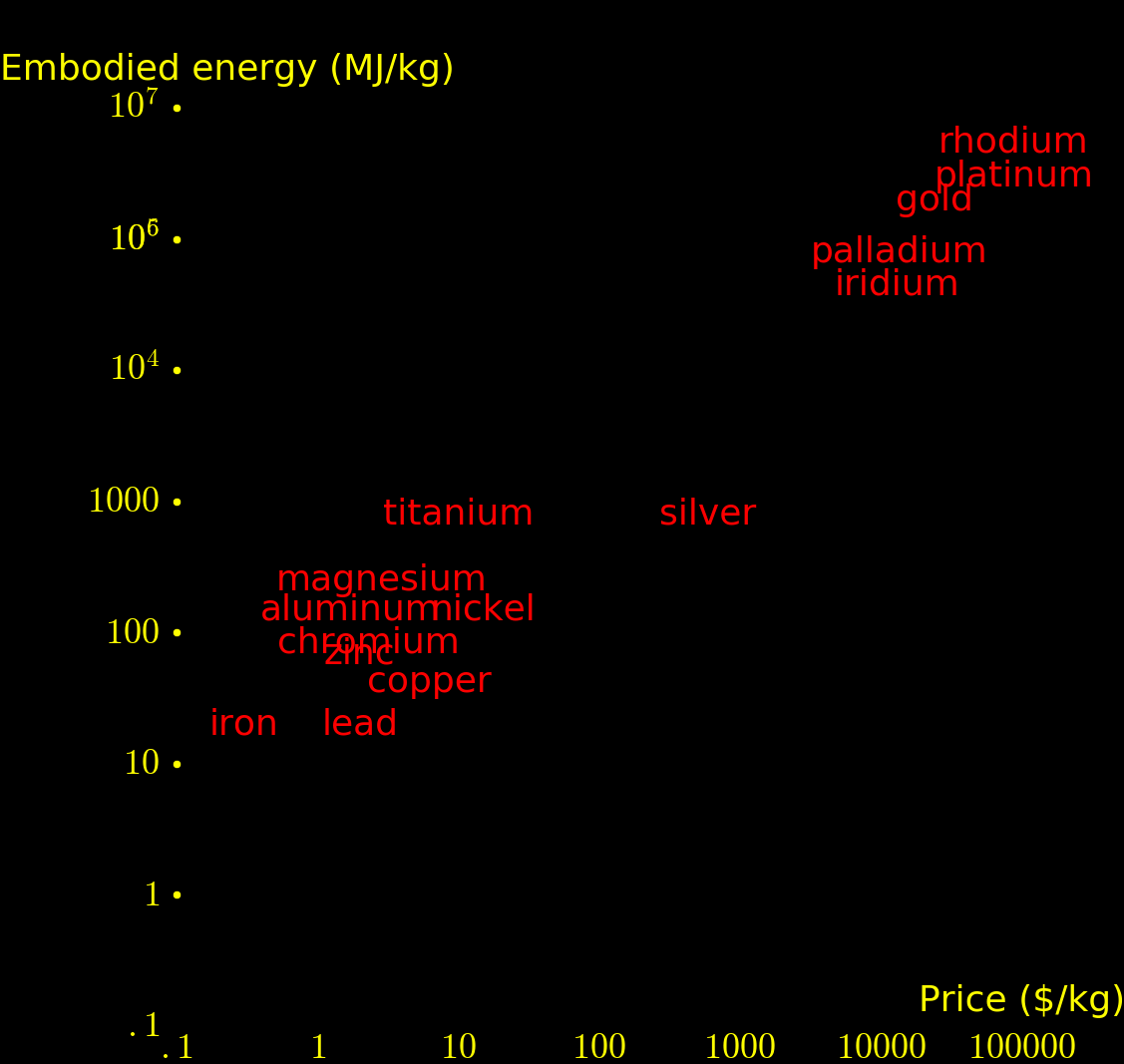 |
|---|
Energy is used in every stage of industry. It's used in the production of primary materials, such as elements, chemicals, plastics, and lumber. It's used again to manufacture things with the primary materials.
The plot shows how much energy the world expends per year for primary materials.
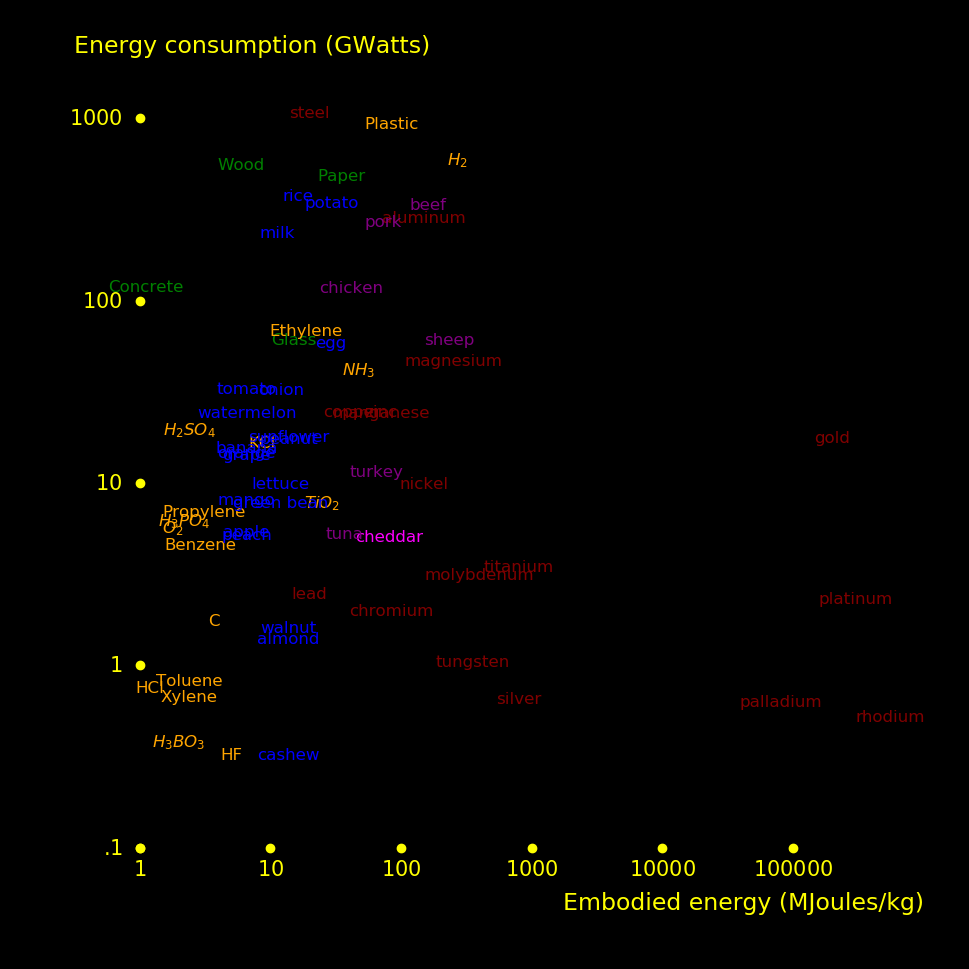 |
|---|
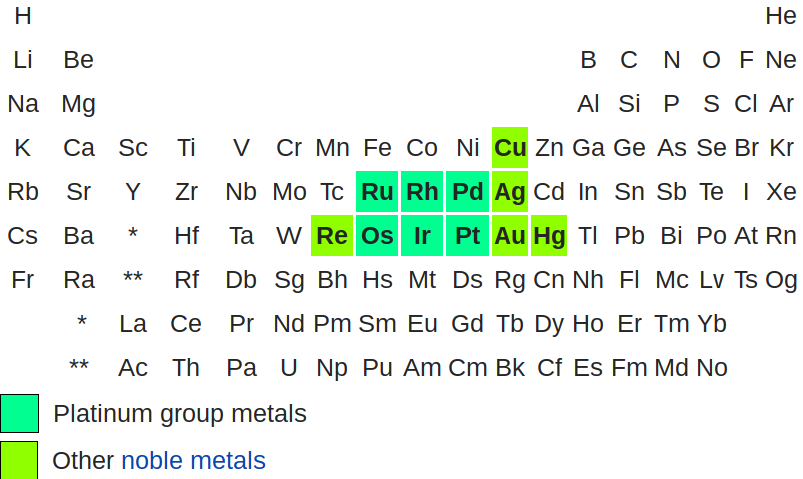 |
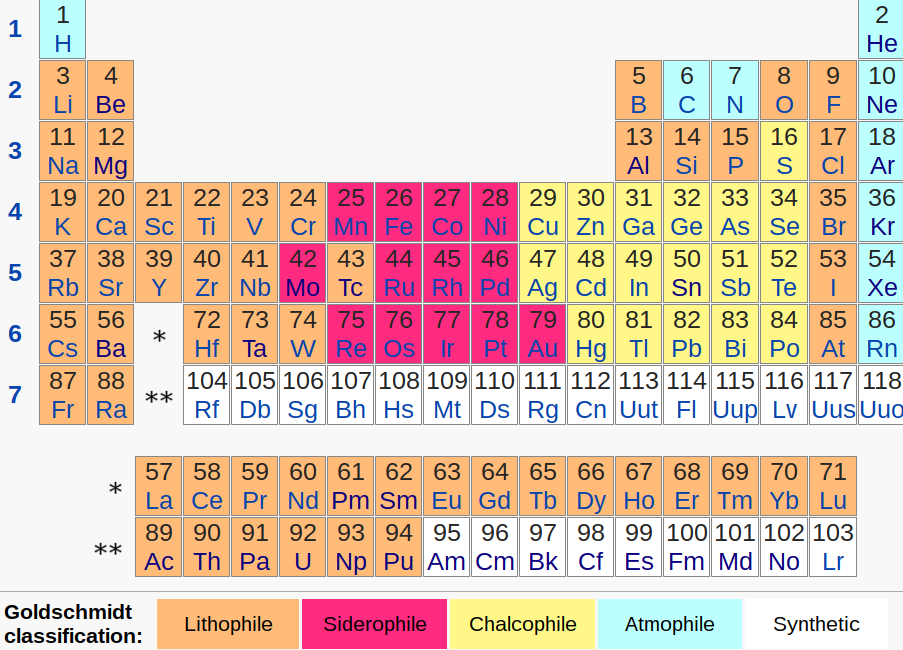 |
|---|---|
Platinum group metals are rare because they are dense and they tend to sink to the Earth's core. They are mostly mined from metal asteroid craters such as the Sudbury crater in Canada and the Vrodefort Crater in South Africa. Metallic asteroids are rich in platinum group elements because they used to be part of the core of a planet.
Siderophile: Iron-living. Tends to sink to the core along with the iron.
Lithophile: Rock-loving. Tends to become included in rock and escapes sinking
to the core.
Chalcophile: Ore-loving. Tends to combine with oxygen and sulfur and escapes sinking
to the core.
Atmophile: Is a gas at room temperature and tends to escape the crust into the
atmosphere.
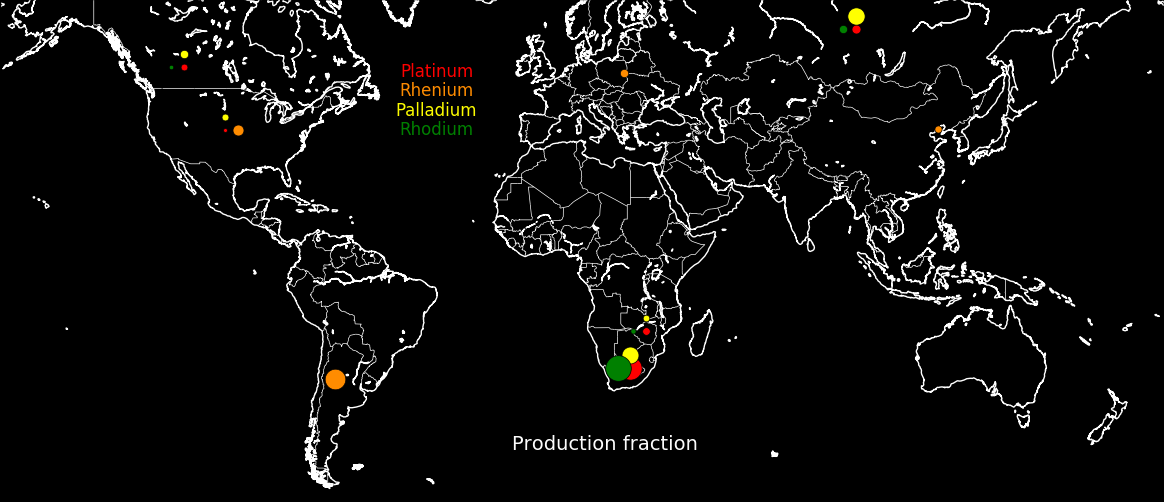 |
|---|
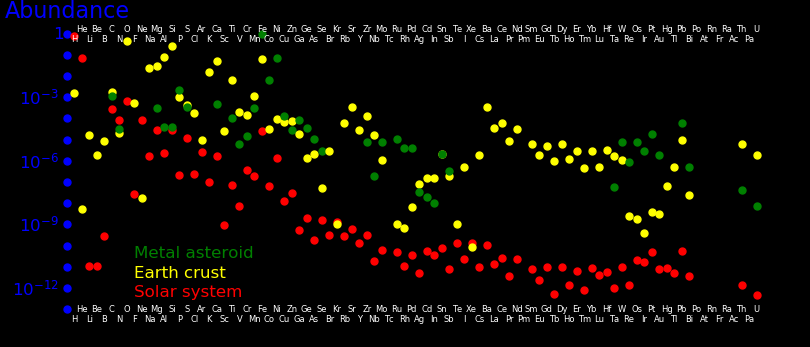 |
|---|
 |
 |
|---|---|
A 300 meter metallic asteroid has 30 billion dollars of platinum group elements, equal to world annual production.
-178918.jpg) |
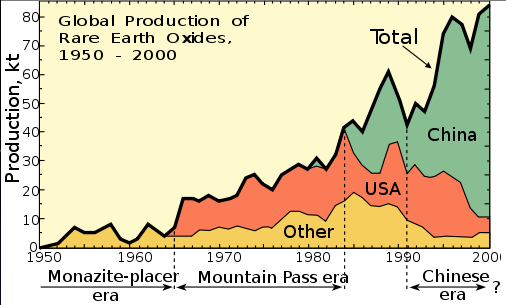 |
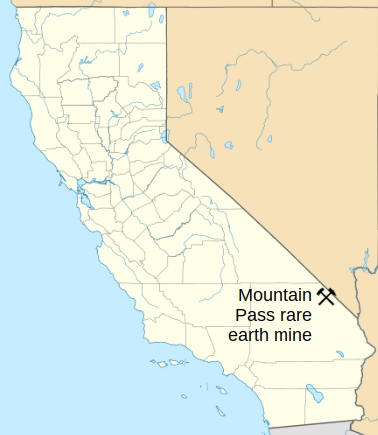 |
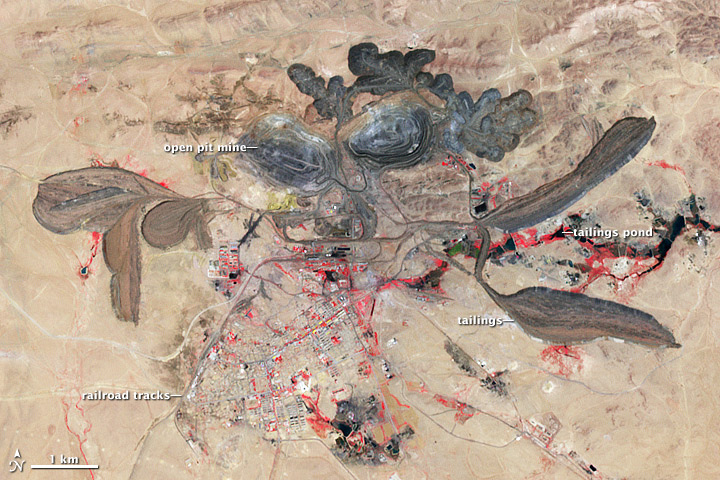 |
|---|---|---|---|
The rare Earth elements are the ones in the row from Lanthanum to Lutetium and they tend to occur together in minerals. They are vital to electronics and 95% of the world's supply comes from the Bayan Obo deposit in China. Uranium and thorium are often found in rare Earth ore.
The Californa Mountain Pass mine closed in 2002. In 2010 China restricted rare Earth exports, prompting subsidies from the U.S. Government to reopen the mine. Mining resumed in 2015 and then ceased in 2016 when the mining corporation went bankrupt.
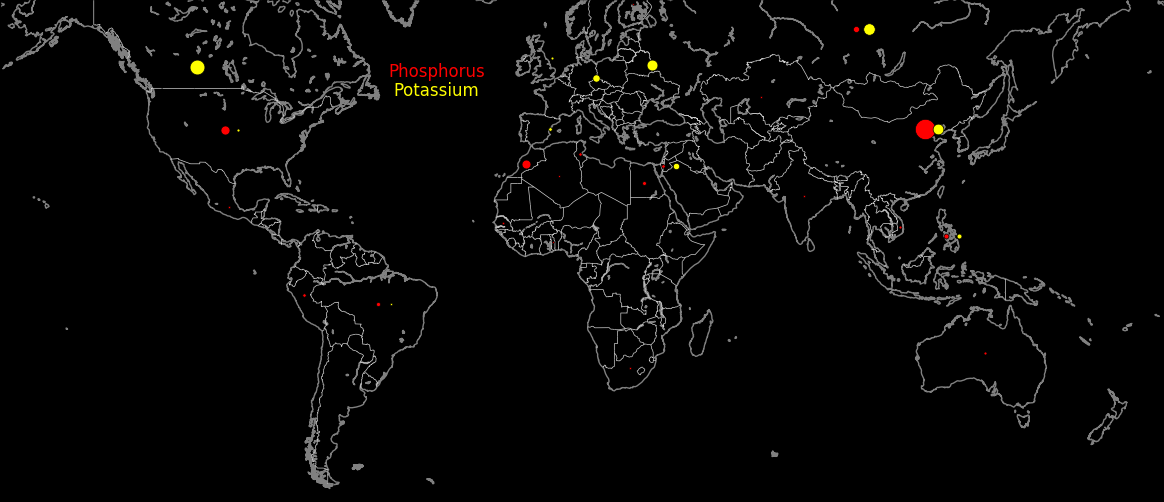 |
|---|
We identify ways to improve education and we expand on each in the sections below.
* Professors: Make professors independent of universities and departments. If they can get students then they're in business.
* Tuition: Most of the money should go directly from the student to the professor that's teaching the student.
* Textbooks: Break the monopoly of price gouging textbook manufacturers by creating a complete set of free online textbooks.
* Private school: Make it possible to have a mix of public and private teachers. All teachers, public and private, can teach in the public school as long as they can get students. This eliminates the overhead of creating a private school.
* Student center: Have a large and comfortable student center. Hold classes in the student center rather than in remote departments.
* Grades: Find better ways than grades to benchmark skill.
* Majors: De-emphasize majors and emphasize skill. Make it possible to customize a curriculum as long as it is rigorous. Eliminate deadweight majors.
* Administration: Eliminate unncessary administration and have students fulful as many administrative functions as possible.
* Private universities: the only private universities costing less than $40000/year are BYU and the College of the Ozarks. Your only options for low tuition are these universities and state schools. Establish cheap private universities.
* Multiple universities: Make it possible to construct a curriculum from multiple universities, including online universities. Make it possible to work and study at the same time. Deemphasize the concept of bundled "full time tuition".
* Data on America universities.
Professors should be independent of the university and the department, and classes should be organized directly with the professor. This enables professors with unique style to exist, as long as they can attract students. Don't try to build a costly research powerhouse. If researchers are included, encourage researchers that bring in grant money or have projects that can be tackled by undergrads.
Minimize administrators.
Hire students for administrative jobs such as librarians, registrars, and security.
Don't try to build an endowment. Spend the money now.
Professors decide the content, not administrators.
The emphasis should be on courses rather than the degree.
Small classes to enable discussion.
Don't assign expensive textbooks. Content should be available online for free.
The textbook market does not operate in the same manner as
most consumer markets. The end consumers (students) do not select the
product, and the product is not purchased by faculty or professors. Therefore,
price is removed from the purchasing decision, giving the publishers
disproportionate market power to set prices high.
This situation is exacerbated by the lack of competition in the textbook
market. Consolidation has reduced the number of major textbook companies from
around 30 to just a handful, reducing competition and inhibiting startups.
Publishers also "bundle" supplemental items into a textbook, such a
online problem sets. Students do not always have the option to purchase these items
separately, and often the one-time-use supplements destroy the resale value of
the textbook.
A 2005 Government Accountability Office (GAO) Report found that the production
of these supplemental items was the primary cause of rapidly increasing prices.
The most important building is the student center, which should have:
Classrooms, rehearsal space
Most universities segment their classrooms by department building, which is
a poor use of space. The laboratories should be sepqrate from the classroom building.
Suppose students paid tuition directly to professors.
Carpet
Under the current system, a bad grade cannot be undone.
As an alternative to grades,
The only grade is "pass" and there is a high standard for passing. If you don't
pass then no record is kept that would disrupt your transcript.
You can take as long as needed to achieve a pass.
Have professors write letters of recommendation that are posted on a website
that a student can link to. This enables a student's unique achievements to be
recorded. The emphasis should be on the professors and the student's
achievements, rather than the university and the
degree. Chuck Norris's letter of
recommendation
Institute flexibility so that credit can be earned by tests, howework, projects,
labs, or any combination of the above.
I you want to be badass, these are the kinds of courses you should take.
Courses should be emphasized over majors.
Professors should be at liberty to have style, and students should have a diversity
of professor styles to choose from.
Feldenkrais Technique. Training is 40 days per year for 3.5 years, at a cost of
4200 $/year. 26th Street. http://feldenkraisinstitute.org
Craniosacral Therapy
Do not get a degree. Degrees costs unnecessary money, course time, and administrative
hoop-jumping. Focus on professors and courses instead.
Search out the most badass professors and courses among all the CUNY schools.
For each course, work hard and obtain a letter of recommendation. On your
CV least each course, the professor, and the content of each course.
Don't take an excessive course load so that you can work a job while taking courses.
Worthy courses:
Wikipedia: The Common Core standards are copyrighted by NGA Center for Best
Practices (NGA Center) and the Council of Chief State School Officers (CCSSO),
which controls use of and licenses the standards. The NGA Center and CCSSO do
this by offering a public license which is used by State Departments of
Education. The license states that use of the standards must be "in support"
of the Common Core State Standards Initiative. It also requires attribution and
a copyright notice, except when a state or territory has adopted the standards
"in whole".
In other words, if you teach in a Common Core state, you do not have the
discretion to modify the standards or to improve them. The standards should be
public domain to empower teachers.
Wikipedia: U.S. President Barack Obama and U.S. Secretary of Education Arne
Duncan announced the Race to the Top competitive grants on July 24, 2009, as a
motivator for education reform. Though states could adopt other college and
career-ready standards and still be eligible, they were awarded extra points in
their Race to the Top applications if they adopted the Common Core standards by
August 2, 2010.
In other words, Federal money was used to compel states to conform to the Common
Core.
Lounges, TV rooms, game rooms
Gym, lockers, etc.
Kitchen, dining rooms, refrigerators.
Temorary offices that professors can use as needed.
Classes taken per year by a student = 10
Students per class = 20
Classes taught per year by a professor = 8
Students taught per year by a professor = 160
Tuition per student per class = 500 $
Tuition per student per year = 5000 $
Tuition received per professor per year =80000 $
It is possible to construct a university where the annual tuition is less than
$10000 and where the professors are well paid.
Comfortable chairs
Flexible lighting with a centralized control panel next to the computer
Whiteboard
Projector that doesn't interfere with the whiteboard
Speaker system
Semesters
Algebra 2
Precalculus 2
Calculus I 1 Calculus should appear as early as possible
Calculus, multivar 1
Differential eq. I 1
Differential eq. II 1 You can never have too much mathematics
Science fundamentals 1 Units and fundamentals of science
Physics I 1
Physics II 1 You can never have too much physics
Chemistry I 1
Chemistry II 1
Biology I 1
Biology II 1
Earth science 1
Astronomy 1
History, American 1
History, European 1
History, Ancient 1 Ancient Greek and Ancient Roman
History of Science 1
History, Modern 1
Writing I 1
Writing II 1
Literature 4
Python programming 2
Foreign language 4
Team sports 8 Team sports build cameraderie
Orchestra 8 Being able to play in a chamber ensemble is important
Theatre 1 Being able to produce a play is important
Total 51
Sports: Wrestling, soccer, tennis.
Physics Mechanics, Electromagnetism
Mathematics Calculus, Multivariable calculus
Shemistry
Biology
Earth science
Astronomy
Anatomy
History Greco-Roman, European, American
Programming Python, Computer graphics, Audio & video editing
Orchestra
Theatre










Mathematics: Calculus I & II. Differential equations. Applied mathematics.
Physics: Mechanics, Electromagnetism, Quantum Mechanics, Advanced classical physics
Chemistry: Chemistry I & II. Organic chemistry.
Biology: Biology I & II. Anatomy
Astronomy
Earth science
Orchestra
History: Western Civilization. America. Science history. Modern international.
Programming: Python. Java. Computer art and animation. App making.
Foreign language
Drawing
Theatre
Audio and video production
Rank In Out of Students Endow Endow/ SAT Free
state state (k) (B$) student (k$)
(k$) (k$) (M$/prsn)
Princeton 1 - 40 8.1 22.7 2.81 1500 60
Harvard 2 - 42 21.0 36.4 1.74 1505 65
Yale 3 - 44 12.3 25.6 2.07 1505 65
Columbia 4 - 49 29.9 9.6 .32 1480 60
Stanford 4 - 44 16.8 22.2 1.32 1475 125
Chicago 4 - 48 15.2 7.5 .50 1510
MIT 7 - 43 11.3 13.5 1.19 1495
Duke 8 - 49 14.8 7.3 .49 1460
U. Penn 9 - 46 21.3 10.1 .48 1455
Caltech 10 - 42 2.21 2.2 1.00 1550
J. Hopkins 11 - 49 21.7 3.4 .16 1445
Dartmouth 12 - 47 6.3 4.7 .74 1455 100
Northwestern 12 - 49 20.3 10.2 .50 1475
Brown 14 - 49 9.2 3.1 .34 1440
Cornell 15 - 45 21.8 6.0 .28 1420
Vanderbilt 15 - 44 12.7 4.1 .33 1465
Wash. U 15 - 48 14.5 6.8 .47 1465
Rice 18 - 42 6.6 5.6 .84 1470
Notre Dame 18 - 48 8.4 .83 .68 1465
UC Berkeley 20 13 38 37.6 1.5 .041 1390
Emory 21 - 46 14.8 6.7 .45
Georgetown 22 - 49 17.9 1.53 .086 1420
UCLA 23 13 36 43.2 1.86 .043
Carnegie Mel 23 - 50 13.3 1.74 .13 1440
USC 23 - 50 42.5 4.7 .111
Virginia 26 15 44 23.7 6.2 .26
Wake Forest 27 - 48 7.8 1.17 .15
Tufts 27 - 51 10.9 1.6 .15 1440 30
Michigan 29 14 43 43.6 10.0 .23 1380
Boston Col 30 - 49 14.1 2.22 .16 72
UNC 30 8.6 34 29.1 3.0 .103
NYU 32 - 46 57.2 3.6 .062
Rochester 33 - 48 11.1 2.0 .18
Brandeis 34 - 50 5.9
William Mary 34 17 41 8.4
Georgia Tech 36 12 32 23.1 1.9 .080
UCSB 37 14 39 23.1
Case Western 37 - 45 10.8 1.8 .16
UC Irvine 39 15 37 30.1
UCSD 39 14 38 29.9
UC Davis 41 14 39 34.5
Illinois 41 16 31 45.1
Wisconsin 41 10 30 43.2 2.47
Penn State 47 18 31 47.0
Florida 47 6 29 50.4
Ohio State 52 10 27 64.9 3.6 .056
Texas 52 10 35 51.3
Washington 52 12 34 44.8
Yeshiva 52 - 40 6.4 1.06
Syracuse 61 - 43 21.5 1.17 .054
BYU 62 - 5 30.5
Fordham 66 - 44 15.2
Iowa 82 8 28 31.4
Stony Brook 89 9 24 24.6
Hoffstra 135 - 44 11.0
New School 135 - 42 10.2
SanDiego St 149 7 18
Wyoming 161 5 15 12.8
Hawaii 168 11 29 19.5
CUNY City 6
CUNY BMCC 5
CUNY York 6 13
CooperUnion - 41 1375
Harvey Mudd - 49 1494
Pomona - 1460
Claremont - 1435
Boston U. 41 - 48 1.6
Rensselaer 41 - 49
Tulane 41 - 50 1.22
Lehigh 47 - 46 1.2
Northeastern 47 - 46 1420
Miami 51 - 46
Pepperdine 52 - 48
Amherst 2.2 1450
Swathmore 1.8 1450
Williams 2.4 1455
UCSF 4.9 1.16 .24
Bowdoin 1.4 1445
Rank Rank according to US News
In state In-state tuition
Out of state Out-of-state tuition
Endow Endowment
Endow/student Endowment per student
Free Free if your parents make less than the given amount







© Jason Maron, all rights reserved.